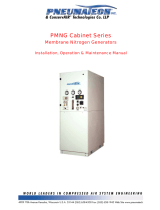Page is loading ...

DPS-50
DIFFERENTIAL PRESSURE SWITCH
MFG. #5401034 - REV D
4/99
PRINTED IN USA PAGE 1 OF 2
UL Listed and CSA Approved
Maximum Rated Pressure: 250 PSI
Maximum Working Pressure: 180 PSI
Pressure Connections: Brass 1/4-18 NPT Female
Adjustable Differential Pressure Range:
8-50 PSID (Increasing Differential Pressure)
Factory Setting: 20 PSID (Increasing Differential Pressure)
Differential Proof Pressure: 180 PSID
(Maximum allowable pressure difference across high/low pressure ports.)
Enclosure:NEMA Type 1 (For indoor use only) Formed sheet metal
with powdercoat fi nish. (Not for use in hazardous locations.)
Switch Contacts:
Snap-Action SPDT (Form C) Switch
22 Amps at 125/250/480 VAC
Conduit Entrance: Opening for 1/2" conduit
Motor Rating: 120VAC 240VAC
Horsepower: 1/2 1
AC F.L.A.: 9.8 8.0
AC L.R.A.: 58.8 48.0
Pilot Duty Rating: 125VA, 120/240 VAC
Ambient Temperature Range: -40°/180° F (-40°/82°C)
Media Temperature Range: 32°/250° F (0°/121°C)
General
The Model DPS-50 is a differential pressure switch used to monitor
the difference in pressure between two pressure sources. A change
in pressure between the high and low pressure ports greater than the
differential pressure setting (8-50 PSID range) will reposition the
switch mechanism to open or close a single electrical circuit by means
of a snap-action electrical switch. This control device is designed
for applications sensing air, water or any fl uid not harmful to brass or
silicone and not classifi ed as a hazardous fl uid.
This control device is designed for use only as an operating control.
Where an operating control failure would result in personal injury
and/or loss of property, it is the responsibility of the installer to add
devices (safety, limit controls) that protect against, or systems (alarm,
supervisory systems) that warn of control failure.
Mounting And Installation
The Model DPS-50 may be mounted in any position on a fl at surface by
two screws or bolts through the holes in back of the case, or by use of the
universal mounting bracket in an area protected from the weather.
Locate switch where vibration, shock and ambient temperature
fl uctuations are mimimal. Be sure to connect the high pressure source
to the port labeled “HIGH” and the low pressure source to the port
labeled “LOW”.
To avoid damage to the control, always hold a wrench on the wrench
fl ats of the pressure ports when tightening pressure connections. Never
tighten the pressure connections by turning the control into the fi tting.
Potter Electric Signal Company • 2081 Craig Road, St. Louis, MO, 63146-4161 • Phone: 800-325-3936/Canada 888-882-1833 • www.pottersignal.com
Stock number 9000100
This device is not intended for applications in explosive environments.
Fig. 1
Wiring
Use properly rated temperature supply wire for the anticipated
service temperature.
Make all electrical connections in accordance with the National
Electrical Code and local regulations.
Route wire under switch bracket to avoid interfering with switch
actuation mechanism. (See Fig. 3)
SWITCH ACTION ON
DIFFERENTIAL
PRESSURE DECREASE
N.C.
N.C.
N.C.
N.C.
N.O.
N.O. N.O.
N.O.COM.
COM.
COM.
COM.
SWITCH ACTION ON
DIFFERENTIAL
PRESSURE INCREASE
DWG# 1034-3
Fig. 2
firealarmresources.com

Adjustments
The differential pressure operating point of the switch can be
adjusted to any point between 8 and 50 PSID by using the “sight-set”
calibrated scale and turning the adjustment knob to the left to raise the
differential pressure actuation point, and turning to the right to lower
the differential actuation point. The scale is calibrated for increasing
differential pressure settings. The repeatability of the set operating
pressure is typically ±1% of the differential pressure range (±.5
PSI). The change in set operating pressure due to change in ambient
temperature is typically less than 1% (based on the differential
pressure range) per 50°F. For best setting accuracy, make the fi nal
adjustment with a pressure gauge and the actual working pressure
encountered in the application.
1/4 -18 NPT FEMALE
“LOW” PRESSURE
CONNECTION
1/4 -18 NPT FEMALE
“HIGH” PRESSURE
CONNECTION
DIFFERENTIAL
PRESSURE SETTING
ADJUSTMENT.
TURN KNOB TO
THE LEFT TO RAISE
THE DIFFERENTIAL
PRESSURE
ACTUATION POINT
AND TURN THE
KNOB TO THE
RIGHT TO LOWER
THE DIFFERENTIAL
PRESSURE
ACTUATION POINT.
SNAP-
ACTION SPDT
SWITCH
ROUTE WIRE
UNDER SWITCH
BRACKET
TO AVOID
INTERFERING
WITH SWITCH
ACTUATION
MECHANISM
.88 DIA HOLE
FOR 1/2"
CONDUIT
CONNECTION
GROUND
SCREW
Adjustable Differential range (PSID) Typical Deadband
(PSI) (Differential
Change to Reset)
Decreasing
Differential Pressure Increasing
Differential Pressure
Minimum Maximum Minimum Maximum
6 44 8 50 2-6
DPS-50
DIFFERENTIAL PRESSURE SWITCH
MFG. #5401034 - REV D
4/99
PRINTED IN USA PAGE 2 OF 2
Potter Model DPS-50 Monitors Condition Of Pipeline Liquid Filter
In a typical liquid fi lter installation, a clean fi lter element will have
a rated pressure drop for a given operating line pressure and rate of
fl ow. As the fi lter accumulates particulate, the resistance to fl ow
increases and the pressure drop increases until the level is reached
when the fi lter element must be cleaned or replaced. Differential
pressure switch Model DPS-50 senses the differential pressure
increase and actuates an alarm or signal light.
Proof Of Flow Application In A Water Chiller System
On a proof of fl ow application in a water chiller system, if ice builds
up inside water chiller, or if tubes become restricted, differential
pressure across chiller increases. Differential pressure switch Model
DPS-50 senses the differential pressure increase and actuates an alarm
or signal light.
DPS-50
OUTLET
EXHAUST
WATER
CONNECTED TO
LOW PRESSURE
CONNECTION
OF THE DPS-50
CHILLER
INLET SUPPLY
WATER
CONNECTED TO
HIGH PRESSURE
CONNECTION OF
THE DPS-50
FILTER
DPS-50
LOW
HIGH
DIRECTION OF FLOW
Fig. 3
firealarmresources.com
/
